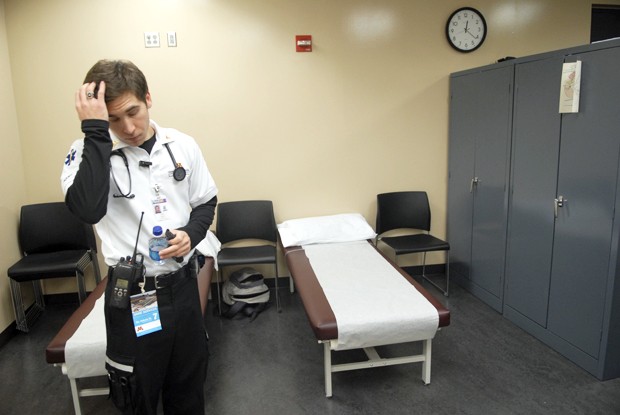Police and paramedics led by Sean Ewen raced through TCF Bank Stadium Saturday to section 143, where a man was having a heart attack. âÄúSlow down, chief!âÄù a police responder pushing a stretcher yelled to Ewen, a University of Minnesota Emergency Medical Services (UMEMS) supervisor. Four members of UMEMS were the first to reach the man and were providing care as responders from Hennepin County Medical Center, the police and fire department arrived. The patient was conscious as he left the stadium. âÄúWeâÄôll get you outside of the crowd here,âÄù a paramedic told the man as he helped push the stretcher through a sea of Gophers football fans. This was the first âÄúmajor eventâÄù to happen at TCF Bank Stadium for Ewen and his crew. But UMEMS was ready. The group of more than 80 volunteers and 10 paid staff members has been providing care at University events ranging from basketball games to concerts at Northrop Auditorium since 1978. They are also on call for disasters and helped during the Interstate 35W bridge collapse. Twenty-five members were at the game Saturday. Roaming teams walked along the top of the stands monitoring the crowds below, while others waited in the three first aid offices dispersed throughout the stadium. The UMEMS team saw about 50 patients during the first game at the stadium, but the number of emergencies slowed down as the season progressed. Volunteer James Bardill said bee stings and heat stroke contributed to the high numbers at the first game; numbers have also dropped as game attendance has decreased. The roaming teams carry radios, defibrillators and heavy duffel bags full of equipment like bandages, breathing tubes and a box of apple juice to raise diabeticsâÄô blood sugar. Xander Castro, a music major and University junior, double-checked a bag. Castro took an EMT class at Hennepin County Medical Center. He wanted to use what he learned and has been volunteering with UMEMS for three months. âÄúIâÄôm hoping to continue for the rest of my life,âÄù he said. Tom Schmitz and Mary Barber-Schmitz, who are Red Cross safety instructors, have worked with UMEMS for 20 years. âÄúItâÄôs a fun thing âĦ It lets us work with real patients,âÄù Barber-Schmitz said. The group includes University graduates, dental students, nursing students and even a pastry chef. Alicia Place, who made a cake for the groupâÄôs recent banquet, said she got involved after finding UMEMS online. Ewen said most of the groupâÄôs promotion comes through person-to-person referral. Volunteers work at least three events a month and attend a monthly meeting. At football games, Ewen and other staff arrive at 8:30 a.m. to set up equipment. Roaming teams check in an hour before game time and stay for a half hour after the game ends. During the game they are dispatched by the command center, where David Dixon uses a computer program called Agile Dispatch to monitor the roaming teams, which appear as green circles on his computer screen. In the central first aid room, Dr. Vicky Mossman, UMEMS medical director, consulted briefly with other volunteers about a patient suffering severe heart burn before being called off to another area of the stadium. Mossman took over as director a year and a half ago. She rewrote the packet of instructions on patient protocol and called other Big Ten schools to determine how many people and supplies the new stadium would require. UMEMS members also toured the Metrodome last year to get an idea of the emergency services there. UMEMS members go through field training where they learn skills unique to the venues they work in, such as how to carry a stretcher on ice. âÄúItâÄôs different than solid ground âĦ youâÄôre slipping and sliding around,âÄù Ewen said. Bardill recalled having to get someone out of the stadiumâÄôs student section in a patient sling, which is like a tarp. The student was âÄúa little too loaded up,âÄù Ewen said. Ewen had to handle one other person having a heart attack last year during a Robin Williams show at Northrop Auditorium. Ewen said âÄúit was dark and noisy,âÄù and the training he received really came into play. âÄúYou need to do it like a habit, by muscle memory,âÄù he said.

Image by Jason Kopp
Sean Ewen, EMT supervisor, takes a breather Saturday in one of the TCF Bank Stadium’s first-aid rooms after safely escorting a patient who fell victim to cardiac arrest out of the stadium at the game.
Medical workers assist Gophers fans
University of Minnesota Emergency Medical Services covers sports and University events.
Published November 16, 2009
0

